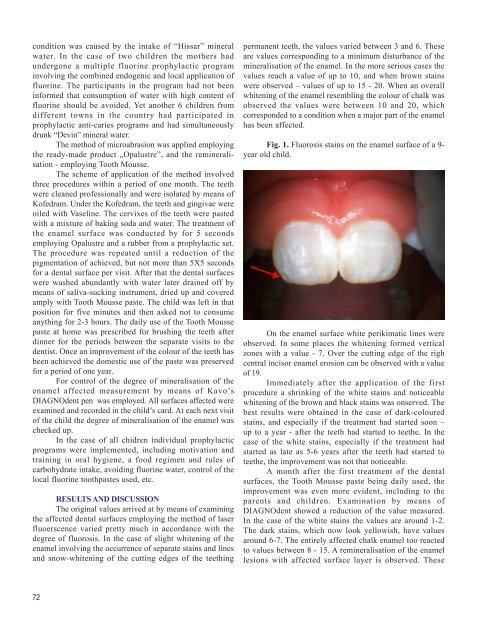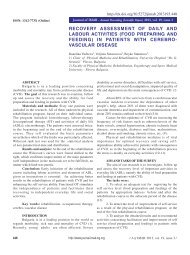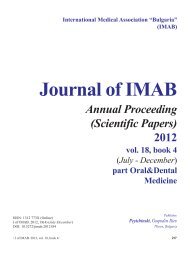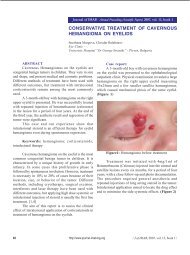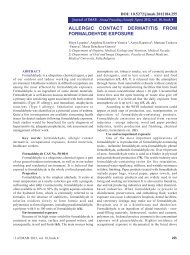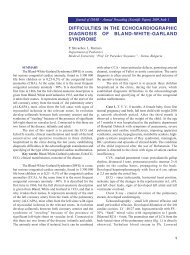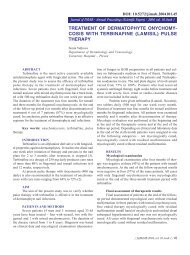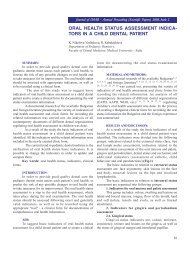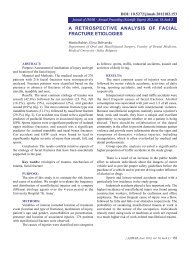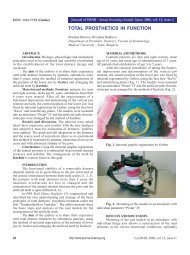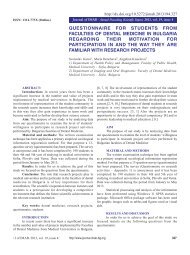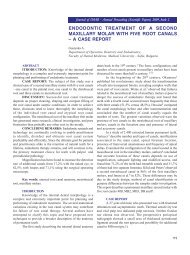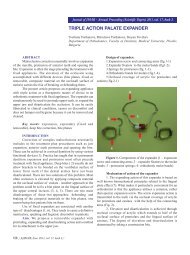TREATMENT OF DENTAL FLUOROSIS - Journal of IMAB
TREATMENT OF DENTAL FLUOROSIS - Journal of IMAB
TREATMENT OF DENTAL FLUOROSIS - Journal of IMAB
You also want an ePaper? Increase the reach of your titles
YUMPU automatically turns print PDFs into web optimized ePapers that Google loves.
condition was caused by the intake <strong>of</strong> “Hissar” mineralwater. In the case <strong>of</strong> two children the mothers hadundergone a multiple fluorine prophylactic programinvolving the combined endogenic and local application <strong>of</strong>fluorine. The participants in the program had not beeninformed that consumption <strong>of</strong> water with high content <strong>of</strong>fluorine should be avoided. Yet another 6 children fromdifferent towns in the country had participated inprophylactic anti-caries programs and had simultaneouslydrunk “Devin” mineral water.The method <strong>of</strong> microabrasion was applied employingthe ready-made product „Opalustre”, and the remineralisation- employing Tooth Mousse.The scheme <strong>of</strong> application <strong>of</strong> the method involvedthree procedures within a period <strong>of</strong> one month. The teethwere cleaned pr<strong>of</strong>essionally and were isolated by means <strong>of</strong>K<strong>of</strong>edram. Under the K<strong>of</strong>edram, the teeth and gingivae wereoiled with Vaseline. The cervixes <strong>of</strong> the teeth were pastedwith a mixture <strong>of</strong> baking soda and water. The treatment <strong>of</strong>the enamel surface was conducted by for 5 secondsemploying Opalustre and a rubber from a prophylactic set.The procedure was repeated until a reduction <strong>of</strong> thepigmentation <strong>of</strong> achieved, but not more than 5Õ5 secondsfor a dental surface per visit. After that the dental surfaceswere washed abundantly with water later drained <strong>of</strong>f bymeans <strong>of</strong> saliva-sucking instrument, dried up and coveredamply with Tooth Mousse paste. The child was left in thatposition for five minutes and then asked not to consumeanything for 2-3 hours. The daily use <strong>of</strong> the Tooth Moussepaste at home was prescribed for brushing the teeth afterdinner for the periods between the separate visits to thedentist. Once an improvement <strong>of</strong> the colour <strong>of</strong> the teeth hasbeen achieved the domestic use <strong>of</strong> the paste was preservedfor a period <strong>of</strong> one year.For control <strong>of</strong> the degree <strong>of</strong> mineralisation <strong>of</strong> theenamel affected measurement by means <strong>of</strong> Kavo’sDIAGNOdent pen was employed. All surfaces affected wereexamined and recorded in the child’s card. At each next visit<strong>of</strong> the child the degree <strong>of</strong> mineralisation <strong>of</strong> the enamel waschecked up.In the case <strong>of</strong> all chidren individual prophylacticprograms were implemented, including motivation andtraining in oral hygiene, a food regimen and rules <strong>of</strong>carbohydrate intake, avoiding fluorine water, control <strong>of</strong> thelocal fluorine toothpastes used, etc.RESULTS AND DISCUSSIONThe original values arrived at by means <strong>of</strong> examiningthe affected dental surfaces employing the method <strong>of</strong> laserfluoerscence varied pretty much in accordance with thedegree <strong>of</strong> fluorosis. In the case <strong>of</strong> slight whitening <strong>of</strong> theenamel involving the occurrence <strong>of</strong> separate stains and linesand snow-whitening <strong>of</strong> the cutting edges <strong>of</strong> the teethingpermanent teeth, the values varied between 3 and 6. Theseare values corresponding to a minimum disturbance <strong>of</strong> themineralisation <strong>of</strong> the enamel. In the more serious cases thevalues reach a value <strong>of</strong> up to 10, and when brown stainswere observed – values <strong>of</strong> up to 15 - 20. When an overallwhitening <strong>of</strong> the enamel resembling the colour <strong>of</strong> chalk wasobserved the values were between 10 and 20, whichcorresponded to a condition when a major part <strong>of</strong> the enamelhas been affected.Fig. 1. Fluorosis stains on the enamel surface <strong>of</strong> a 9-year old child.On the enamel surface white perikimatic lines wereobserved. In some places the whitening formed verticalzones with a value - 7. Over the cutting edge <strong>of</strong> the righcentral incisor enamel erosion can be observed with a value<strong>of</strong> 19.Immediately after the application <strong>of</strong> the firstprocedure a shrinking <strong>of</strong> the white stains and noticeablewhitening <strong>of</strong> the brown and black stains was onserved. Thebest results were obtained in the case <strong>of</strong> dark-colouredstains, and especially if the treatment had started soon –up to a year - after the teeth had started to teethe. In thecase <strong>of</strong> the white stains, especially if the treatment hadstarted as late as 5-6 years after the teeth had started toteethe, the improvement was not that noticeable.A month after the first treatment <strong>of</strong> the dentalsurfaces, the Tooth Mousse paste being daily used, theimprovement was even more evident, including to theparents and children. Examination by means <strong>of</strong>DIAGNOdent showed a reduction <strong>of</strong> the value measured.In the case <strong>of</strong> the white stains the values are around 1-2.The dark stains, which now look yellowish, have valuesaround 6-7. The entirely affected chalk enamel too reactedto values between 8 - 15. A remineralisation <strong>of</strong> the enamellesions with affected surface layer is observed. These72


